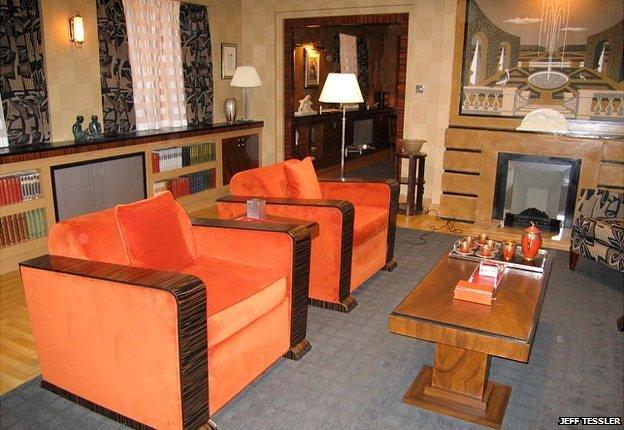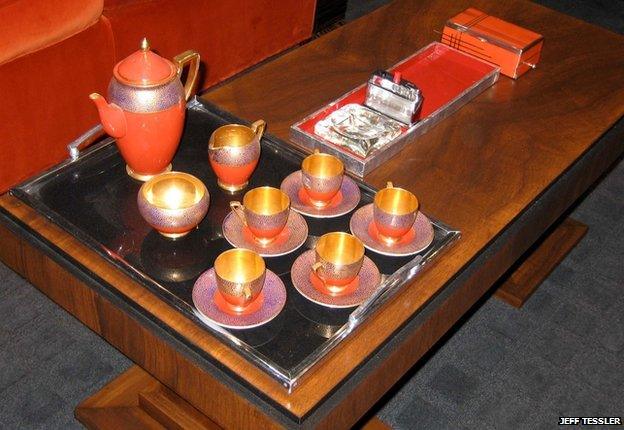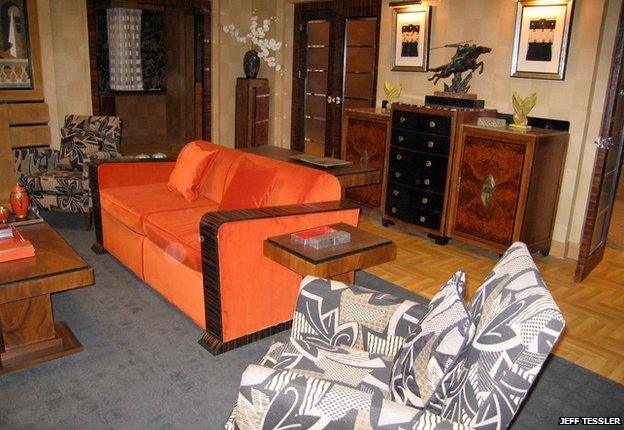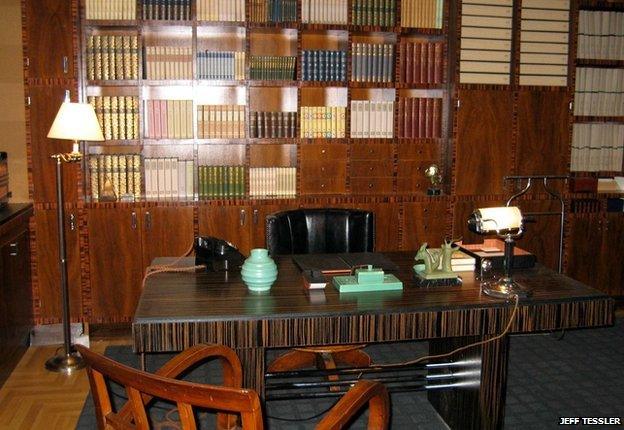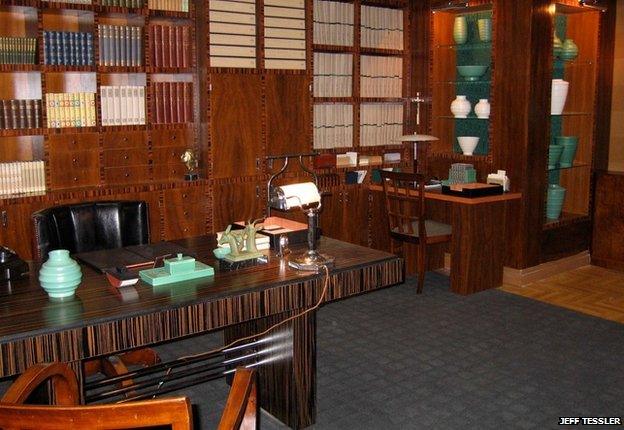Goodbye to the splendid 1930s world of Poirot
- Published
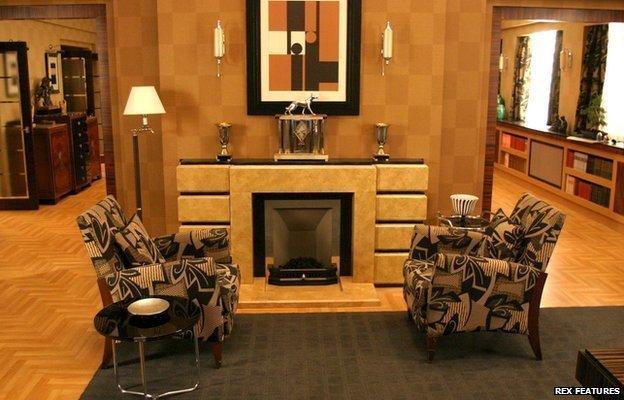
The fox clock on the mantelpiece was bought by David Suchet
David Suchet has had his last outing as Poirot. The TV adaptation was a glorious love letter to the design and architecture of the 1930s.
One object beautifully sums up David Suchet's Hercule Poirot. The tiny "lapel pin vase", a metal brooch holding a cut-down flower, was present through much of the 24 years of the series.
It is both a significant object from a particular story (The Chocolate Box), but also an emblem of Poirot's character. The Belgian detective is meticulous - in his detection, but also in his dress, in his groomed moustache and in his immaculate modern (for the 1930s) flat.
"They had made a decision in the very early days that although the books run over nearly 60 years that they would still set everything in the mid-1930s," says Jeff Tessler, production designer on Poirot from 2005.
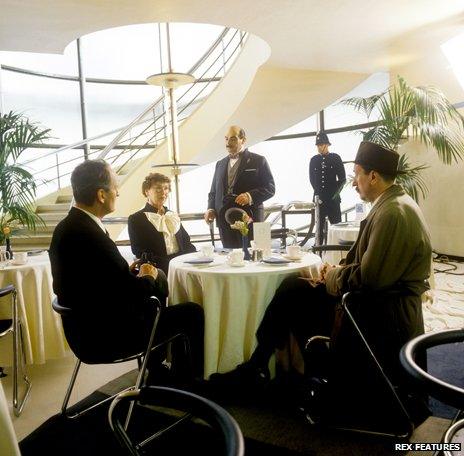
A victim in The ABC Murders worked at the De La Warr Pavilion
A pantheon of modernist and Art Deco British buildings acted as backdrop to a series of murders of the well-to-do.
The Burgh Island Hotel, reached at high tide by a distinctive "sea tractor", was the setting for Evil Under the Sun. The celebrated De La Warr Pavilion in Bexhill-on-Sea appeared in the ABC Murders. The Midland Hotel in Morecambe, built in the Streamline Moderne style, appeared in and was mentioned by name in Double Sin.
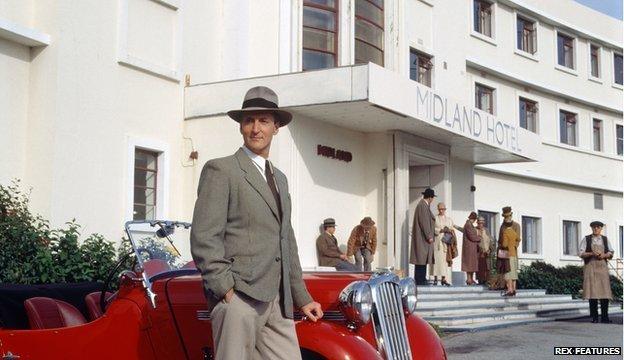
The Midland, a haunt of Coco Chanel, Sir Laurence Olivier and Noel Coward, featured in Double Sin
Joldwynds, a modernist house in Surrey, featured in more than one show. The episode King of Clubs uses both High and Over House in Amersham, Bucks, and also the iconic Hoover building in west London. Other stark white locations include St Anne's Court in Chertsey.
Then there's Poirot's flat. Given as "Whitehaven Mansions", it's actually Florin Court in Charterhouse Square, Clerkenwell, in central London.
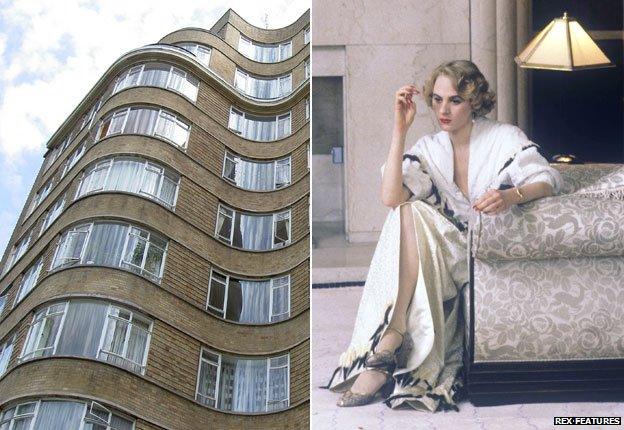
Poirot's fictional home Whitehaven Mansions (left) and a scene from King of Clubs
There have actually been two flats. Pre-2005, it was pale and elegant - glass bookshelves with a semi-circle motif, chrome tubular leather seated dinner chairs looking rather like Mies van der Rohe's MR10s, external and so on.
Then in 2005 Tessler changed the feel completely. "His first apartment was quite white and stark. Eight years ago we moved him upstairs. I built a bigger apartment for him. Instead of the black and white Art Deco, I made it more continental. Partly because he is Belgian, we wanted a warm look - a lot more French and Belgian Art Deco, richer and more striking.
"We used a lot of English designed pottery from the period, people like Keith Murray, but also a lot of French Art Deco figurines and furniture."
Those close to the show note that the look in the earlier series was technically not Art Deco.
"We tried not to be anachronistic," producer Brian Eastman said in a recent interview, external. "And the set was 30s modern, not actually Art Deco, because Agatha Christie had explained in a profile of Poirot that Art Deco was too flamboyant for him."
But whether Art Deco or modernist, all most viewers would have picked up was the nostalgic opulence, perfect for escapist Sunday night telly. The flat was both luxurious and a reflection of Poirot's personality.
Inside Poirot's second Whitehaven Mansions apartment
"People understand that it is fiction, it is drama - it's a more extreme example than you might find anywhere in an English apartment," says Tessler. "Everything in it has to reflect Poirot's obsession. The furniture is square because he hated curves. We were very careful in the design of the thing to reflect those obsessions."
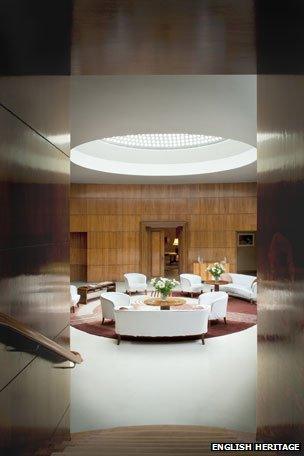
Part of Three Act Tragedy was set at Eltham Palace
For the last five years, fan Eirik Dragsund has been painstakingly rewatching the series for his blog.
"There is a clock on the mantelpiece [with what looks like a silver fox or dog on top]," Dragsund notes. "David Suchet found it in an antique shop and bought it for the series."
The purchase of the clock made sense as it reflected an episode from the books, external where Poirot had won a bet with a French detective, Dragsund notes.
In the later years of Poirot, the action often moved to country houses, notes Tessler, and away from modernist and Art Deco settings. "[But] we did make a decision whenever we were in London to try and keep some of the 30s feel."
So the production team used locations like Freemasons Hall and the Palm Court at the Sheraton hotel in Park Lane.
Poirot continues to be a reference point for any fans of Art Deco. Interior designer Jeremy Grove, of Sibley Grove, who has just finished an Art Deco-themed ballroom in Saudi Arabia, admits having used the show in "mood boards" - collections of images that demonstrate a look or feel to a client - in the past.
Grove appreciates the styling of the show. "They got their locations really spot on," he says, noting the example of Eltham Palace, the interiors of which were used in the episodes Three Act Tragedy and Death on the Nile. Deco themes are still regularly used by designers and manufacturers, he explains. "It is still more decorative than super-contemporary stuff. It's all straight lines and geometry."
Tessler agrees the show may have magnified interest in Art Deco and modernist furniture. "It was hugely influential. There was definitely a renewed interest in Art Deco."
And perhaps the most important part of the design of the show was that it helped Suchet build up the character. "There are things in his apartment that are important to David Suchet - a wonderful verdigris antelope head on his desk. That's always been there," says Tessler.
They were among the objects that made him feel at home.
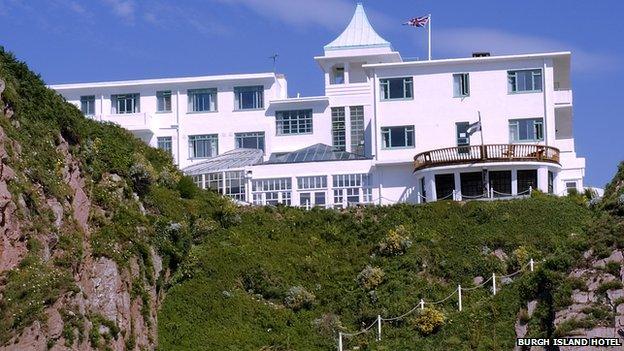
Christie was inspired to write And Then There Were None at Burgh Island, which featured in Evil Under the Sun
Follow @BBCNewsMagazine, external on Twitter and on Facebook, external
